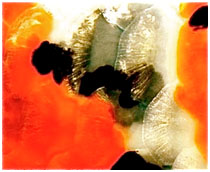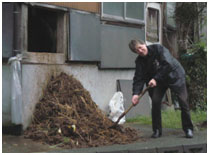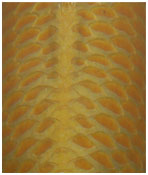There have been several occasions that a Koi supplied by me has taken the important award given by the judges and yet I feel another Koi entered by another person should have taken the award instead. I have voiced concerns about this to the judges as nicely as possible despite the importance of the judgement but this has never once altered the given result.
Regarding the ability to ‘assess’ a particular Koi, which really means one, is ‘evaluating’ it in monetary terms; there are several yardsticks one can consider.
1. Pattern – In patterned varieties, this is of major consideration whether it is a small example with potential to ‘edge’ and stabilise in later years or it is already stabilised in a larger size. Whatever the age/size; unique, classic or unusual patterns play a very great part in the overall evaluation despite the preachings of many Koi judges who dispute the importance of pattern. In non-patterned varieties, quality of true pigmentation plays a great part.
2. Body & Frame – another series of words that cannot possibly be explained unless ‘perfect silhouettes’ of top and side views of perfect Koi can be produced – IN ALL AGES OF GROWTH. To reduce this to simplicity, the ‘perfect shape’ of a one year-old human infant would look horrendous if it was merely blown-up in the same ratio to produce that of an adult athlete. This applies to the ‘generalised’ desired shape of a perfect Nishikigoi in all stages of growth. One thing is certain, in all sizes, and that is any deformities/variations in skeleton, fins and eyes bring serious de-merits as do any visible traces of prior cosmetic alterations by intentional surgery or previous visible signs of past bacterial infections on the body.
3. Pigmentation quality (only really applies to beni/hi but also includes sumi) – this is almost impossible to show the very best possible examples, even with today’s photographic capabilities at our disposal. The reason is that, similar to skeleton changes – covered in 2. above, desirable high quality beni pigmentation and its depth increases with each passing year to ‘thicken’ or produce ‘another layer of paint’. The actual ‘colour’ can vary from a yellow-orange right through to a beautiful bright red as the Koi grows.
4. Skin Lustre or ‘shine’ – although this can be detected readily by the naked eye (again in Go-Sanke varieties only) – it can be far more easily realised when a particular Koi is gently turned to reveal the flank/s. In high quality examples the white ground takes on a very real silky shine and whilst this will reduce slightly as the Koi grows, the majority will remain given good conditions to produce a finished and more conservative effect. On this part of evaluation, the subject of ‘fukurin shine’ often crops up but the term is a generalisation of two very different visual effects. One refers to the edging of scales themselves after the central part of the scale has been almost ‘indented’ as if by way of thumb pressure and the scale surround appears to be higher and ‘framed’ On excellent examples this produces a wonderful vignette appearance that carries with it a true mark of ‘desirability’ – these are rare examples to find. The other visible production of fukurin relates to the actual scale where, at first, will display a Gin Rin reflection. Even today, many experienced judges can still not come to terms with this and, as a result, many non-Gin Rin entries to a show that do show this skin appearance have been wrongly removed from classes they really should have been entered into and relegated to lesser Gin Rin classes.
True, high quality ‘skin’ but no photograph can ever do it justice.
4a. Fukurin – The term ‘Fukurin’ or ‘Fukurin Skin’ is mentioned from time to time, especially at Koi shows. This is all it is – ‘a term’ – some other terms are ‘Pearl’ in relation to Gin Rin; ‘Maruzome’; lately ‘Atarashi’; ‘Kamisori’ and there are several other descriptive terms relating to skin and formations of pigmentation. This does not mean they are ‘must-haves’ in any sense if a Koi entered is to take best award in its size and classification. There may well be other entries without these skin attributes that are far better than the ones possessing these skin descriptions. It is rather like looking at a lady with a beauty spot, some like this whilst others do not.
However, ‘Fukurin Skin’ produces many arguments between owners, suppliers, benching teams and judges at Koi shows and so it is best I try to give my attempt at an explanation.
To further confuse this, breeders use the term ‘fukurin’ for two entirely different skin appearances!
The first is applied to varieties such as Yamabuki; Purachina; Chagoi; Ochibashigure and some others but it is also evident on some Go-Sanke specimens where it is the actual individual scale that is referred to and the effect it produces when viewed on the overall body of the Koi. Many westerners refer to this effect as ‘matsuba’, ‘vignette’ or ‘reticulation’ when it is really fukurin.
Incidentally, at one lecture I gave some years ago in Yorkshire, the chairman walked out after he heard me state the term for the first time!
This is an example of the term fukurin when applied to non-Go-Sanke varieties, in this case Yamabuki.
The centre of the scale appears to be a darker colour as opposed to the border or frame as shown. It does produce a very striking effect where it seems that the centre of the scale has a ‘thumbprint’ or indentation. Very high quality Chagoi can produce this effect together with a delicate beige skin. What confuses this more is that some breeders often refer to some Chagoi with visible pigmentation edgings to the scales as fukurin when it is not, instead it is ‘reticulation’.
Next is the fukurin that produces endless arguments, especially with Koi judges. Of the high quality small Koi produced today, in sizes up to nisai (two years old) there is a definite shine to the white ground that is of importance where quality is concerned. Many breeders use this skin quality when selecting their tategoi. More often than not, this ‘shine’ will reduce in immediate appearance as the Koi grows but will always remain when the flank is exposed in later years after lifting the Koi from the water. Without exception, this second description of fukurin applies to Go-Sanke varieties although I have yet to witness this on Showa.
 Although I have seen this on several Kohaku it is almost always a Sanke that produces major confusions at shows.
Although I have seen this on several Kohaku it is almost always a Sanke that produces major confusions at shows.
This is a close-up of scales showing ‘fukurin shine’ on a four year Sanke and, in some cases, it is even stronger in lustre than this example. This is present on the white skin and the sumi and beni pigmented scales. It produces an overall ‘silk effect’ to the finish of the Koi but usually only on the flanks of the body around the shoulder and dorsal areas. Many show officials class this as ‘Gin-Rin’ and many Koi showing this very desirable and high quality skin have been entered wrongly into ‘Gin-Rin’ class; in reality they should have been entered into the far more desirable Sanke or Kohaku classes that command far more kudos in terms of importance and thus the far greater value of a particular Koi in terms of showing.
 Here are examples of true ‘Dia’ or Gin Rin Koi bred specifically as such, where the full reflective lustre of the scales is constant throughout the body and is not confined to specific areas around the flanks.
Here are examples of true ‘Dia’ or Gin Rin Koi bred specifically as such, where the full reflective lustre of the scales is constant throughout the body and is not confined to specific areas around the flanks.
I have yet to see this kind of confusion between gin rin and fukurin in any Japanese shows I have judged at or attended but it has produced some great debates in shows in the USA and the UK. Despite the fact that there is an obvious difference between the two opposing appearances, the battle continues to rage.
5. Sex. In truth female Koi are always more valuable than males although there have been isolated instances where a male Koi has taken the highest award in prestigious Koi shows. Male Koi do look far more attractive in terms of stunning pigmentation when young but this does not last forever as there is a crossroads that will be faced in later years when ‘body’ becomes extremely important. It is then that the slim male skeleton will be overtaken when compared against a female skeleton in the same size.
Whilst all of the above, and some others, need to be taken into account when assessing a particular Koi; finding these examples in order to see them close-up is another matter completely. There is no doubt that the world demand for high quality Koi has seriously decreased over recent years; as a result, many importers will not take the risk of bringing in Koi of this class for sale in the vague hope that someone will purchase them. As a result, the actual quality of Koi offered for sale today outside of Japan has suffered due to a combination of reduced demand together with horrendous exchange rates now forcing the price of any imported Koi from Japan to almost 100% more than it was in 2004. It goes without saying – although many still believe the opposite, but I’ll say it again for the thousandth time –
‘There are cheap Koi and there are good Koi – but there are no cheap, good Koi’
I am also being asked questions now as to if a particular Koi seen for sale will ‘grow’ to jumbo proportions and can this be detected by measuring the head from the tip of the nose to the rear of the gills and then applying some ‘rule-of-thumb ratio’ to this?
 One answer to this is that the original parent carp (Magoi) that went on to produce Nishikigoi came for various carp strains from different countries. These strains were far more than the oft-quoted Tetsu Magoi and Asagi Magoi but many Nishikigoi still have traces of these genes present and the original strains produced body and shape variations no matter how minimal. It is only the breeder who uses his own particular Oyagoi developed and watered-down from these strains over many decades who can, from experience of his own offspring, come out with statements such as this.
One answer to this is that the original parent carp (Magoi) that went on to produce Nishikigoi came for various carp strains from different countries. These strains were far more than the oft-quoted Tetsu Magoi and Asagi Magoi but many Nishikigoi still have traces of these genes present and the original strains produced body and shape variations no matter how minimal. It is only the breeder who uses his own particular Oyagoi developed and watered-down from these strains over many decades who can, from experience of his own offspring, come out with statements such as this.
Please do bear in mind it is IMPOSSIBLE to generalise on this matter and even if a breeder does give his genuine opinion that ‘this Koi will grow to over 85cms’ – he bases this on HIS own growing methods and facilities and not those of the potential buyer.
Thousands search endlessly for one that has ‘slipped the net’ and they will continue forever without any success at all. Today, of the one’s who understand quality and also wish to find and buy them, then visits to Japan are the only real answer. It was true in the UK, that up to the late 1980’s it was possible to purchase very high quality Koi right here that did go on to take important awards at our national show. Alas, those days are gone forever.
At the end of the day, all of this boils down to searching endlessly and learning more and more with every special Koi viewed in order to try and ‘perfect’ one’s own ‘eye’. Despite the many and valid attempts to try and explain all of this, mine included, it is indeed an impossibility.
 A word of warning though, it is a long journey by necessity. However, as I mentioned at the beginning of this page, all of this cannot possibly be ‘taught’ it has to be ‘discovered’ – it also produces a wealth of self-acclaimed ‘experts’ – beware!
A word of warning though, it is a long journey by necessity. However, as I mentioned at the beginning of this page, all of this cannot possibly be ‘taught’ it has to be ‘discovered’ – it also produces a wealth of self-acclaimed ‘experts’ – beware!
Once again, this comes to mind!





